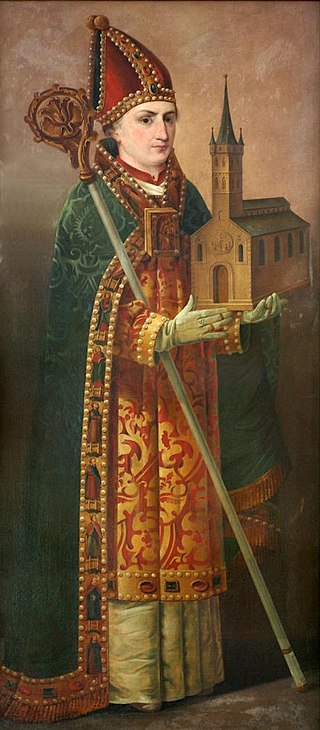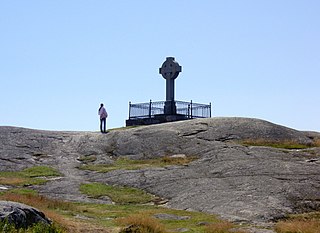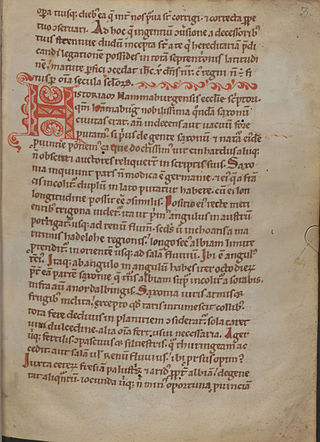Related Research Articles

Ansgar, also known as Anskar, Saint Ansgar, Saint Anschar or Oscar, was Archbishop of Hamburg-Bremen in the northern part of the Kingdom of the East Franks. Ansgar became known as the "Apostle of the North" because of his travels and the See of Hamburg received the missionary mandate to bring Christianity to Northern Europe.

Birka, on the island of Björkö in present-day Sweden, was an important Viking Age trading center which handled goods from Scandinavia as well as many parts of the European continent and the Orient. Björkö is located in Lake Mälaren, 30 kilometers west of contemporary Stockholm, in the municipality of Ekerö.
Ratramnus a Frankish monk of the monastery of Corbie, near Amiens in northern France, was a Carolingian theologian known best for his writings on the Eucharist and predestination. His Eucharistic treatise, De corpore et sanguine Domini, was a counterpoint to his abbot Paschasius Radbertus’s realist Eucharistic theology. Ratramnus was also known for his defense of the monk Gottschalk, whose theology of double predestination was the center of much controversy in 9th-century France and Germany. In his own time, Ratramnus was perhaps best known for his Against the Objections of the Greeks who Slandered the Roman Church, a response to the Photian schism and defense of the filioque addition to the Niceno-Constantinopolitan Creed.

Swedish pre-history ends around 800 AD, when the Viking Age begins and written sources are available. The Viking Age lasted until the mid-11th century. Scandinavia was formally Christianized by 1100 AD. The period 1050 to 1350—when the Black Death struck Europe—is considered the Older Middle Ages. The Kalmar Union between the Scandinavian countries was established in 1397 and lasted until King Gustav Vasa ended it upon seizing power. The period 1350 to 1523 – when king Gustav Vasa, who led the unification of Sweden in the Swedish War of Liberation, was crowned – is considered the Younger Middle Ages. During these centuries, Sweden gradually consolidated as a single nation.
Saint Rimbert was archbishop of Hamburg-Bremen, in the northern part of the Kingdom of East Frankia from 865 until his death in 888. He most famously wrote the hagiography about the life Ansgar, the Vita Ansgari, one of the most popular hagiographies of middle ages.
Olof was a Swedish monarch or local ruler who ruled over Birka, an important port town, and possibly Uppsala, an important early Swedish political center, in about 852, when the Catholic missionary Saint Ansgar made his second voyage from Germany to Birka in about the year 851 or 852 A.D. He had an ambivalent attitude to Christianity, and was known as a successful warrior king in the Baltic region.
Gottschalk of Orbais was a Saxon theologian, monk and poet. Gottschalk was an early advocate for the doctrine of two-fold predestination, an issue that ripped through both Italy and Francia from 848 into the 850s and 860s. Led by his own interpretation of Augustine's teachings on the matter, he claimed the sinfulness of human nature and the need to turn to God with a humility for salvation. He saw himself as a divine vessel calling all of Christianity to repent for decades of Civil War. His attempts of this new Christianisation of Francia ultimately failed, his doctrine was condemned as heresy at the 848 council of Mainz and 849 council of Quierzy. Following his conviction as a heretic Gottschalk remained stubborn to his ideology disobeying the ecclesiastical hierarchy, making him an "actual heretic in the flesh", for this disobedience Gottschalk was placed in monastic confinement; however the shockwaves his ideology sent around Western Christendom refused to stop reverberating, Gottschalk managed to win over more followers and the threat remained up until his death in 868.

The House of Munsö, also called the House of Björn Ironside, the House of Uppsala or simply the Old dynasty, is the earliest reliably attested royal dynasty of Sweden, ruling during the Viking Age. None of the names suggested for the dynasty are universally accepted and most are problematic; the name "House of Munsö" derives from a questionable and speculative theory that they would have ruled from the island of Munsö and the name "House of Björn Ironside" derives from the supposed founder of the dynasty, Björn Ironside, who is often seen as a legendary, rather than historical, figure.
Grobiņa is a town in South Kurzeme Municipality in the Courland region of Latvia, eleven kilometers east of Liepāja. It was founded by the Teutonic Knights in the 13th century. Some ruins of their Grobina castle are still visible. The town was given its charter in 1695.

The Diocese of Strängnäs is a part of the Lutheran Church of Sweden and has its seat in Strängnäs Cathedral in Strängnäs, south of Lake Mälaren. The diocese is made up of the two provinces Närke and Södermanland.

Saint Sigfrid of Sweden (Swedish: Sigfrid, Latin: Sigafridus, Old Norse: Sigurðr, Old English: Sigefrið/Sigeferð) was a missionary-bishop in Scandinavia during the first half of the 11th century. Originally from England, Saint Sigfrid is credited in late medieval king-lists and hagiography with performing the baptism of the first steadfastly Christian monarch of Sweden, Olof Skötkonung. He most likely arrived in Sweden soon after the year 1000 and conducted extensive missions in Götaland and Svealand. For some years after 1014, following his return to England, Sigfrid was based in Trondheim, Norway. However, his position there became untenable after the defeat of Olaf Haraldsson.
Adalgar, venerated as Saint Adalgar, was the third archbishop of Bremen from 888 until his death. Adalgar is revered as a saint in the Roman Catholic and Eastern Orthodox Churches. His feast day is 29 April.

The Christianization of Scandinavia, as well as other Nordic countries and the Baltic countries, took place between the 8th and the 12th centuries. The realms of Denmark, Norway and Sweden established their own archdioceses, responsible directly to the pope, in 1104, 1154 and 1164, respectively. The conversion to Christianity of the Scandinavian people required more time, since it took additional efforts to establish a network of churches.

Gesta Hammaburgensis ecclesiae pontificum is a historical treatise written between 1073 and 1076 by Adam of Bremen, who made additions (scholia) to the text until his death . It is one of the most important sources of the medieval history of Northern Europe, and the oldest textual source reporting the discovery of coastal North America.

Horik I or Hårik was a king of the Danes. He was co-ruler from 813, and sole king from c. 828 until his violent death in 854. His long and eventful reign was marked by Danish raids on the Carolingian Empire of Louis the Pious, son and successor of Charlemagne.
Saint Unni was an archbishop of Hamburg-Bremen. He died as a missionary in Birka in Sweden, where he tried to continue Ansgar's work.

Horik II, also known as Hårik or, in late sources, Erik Barn, was King of the Danes from the fall of Horik I in 854 to an unknown date between 864 and 873. During his reign the Danish kingdom showed tendencies of breaking up. After his demise under unknown circumstances, Denmark entered a long period of obscurity, until the rise of the Jelling dynasty in the 10th century.
The history of Christianity in Denmark started with Saint Willibrord's unsuccessful mission among the Danes in the early 8th century.
Björn was a Swedish monarch or local ruler who ruled over Birka, an important port town, and possibly Uppsala, an important early Swedish political center, around the year 829. His existence is attested by the nearly contemporary account Vita Ansgari, written by the missionary Rimbert, who visited Sweden alongside Ansgar in c. 852. He is in fact the first Swedish figure referred as king who is known from a reasonably reliable source. Older Swedish historiography often identified the king with the legendary figure Björn at Haugi, who was supposedly a Swedish ruler in the generation before the youth of Harald Finehair of Norway. This identification is however considered unverifiable, since Björn at Haugi may have actually been a Norwegian local ruler who was later constructed as a Swedish king. Although the genealogy of early Swedish local rulers is not known, Björn is assumed to have belonged to the House of Munsö, which would later produce Eric the Victorious, generally considered to be Sweden's first king. The royal names attested in the ninth century, namely, also occur among the kings and princes in the late Viking age, perhaps suggesting a genealogical continuity.
Eric was a Swedish monarch or local ruler who ruled over Birka, an important port town, and possibly Uppsala, an important early Swedish political center, and is mentioned as dead by 852. His existence is attested by the nearly contemporary account Vita Ansgari, written by the missionary Rimbert, who visited Sweden alongside Ansgar in c. 852. By the time of their visit, a king by the name Olof ruled, with Eric being deceased since a while.
References
- ↑ Palmer, James T. (2004). "Rimbert's Vita Anskarii and Scandinavian Mission in the Ninth Century". The Journal of Ecclesiastical History. 55 (2): 235–236. doi:10.1017/S0022046904009935. hdl: 10023/1554 . ISSN 1469-7637.
- ↑ Jesch, Judith (1991). Women in the Viking Age. Boydell Press. p. 89. ISBN 978-0-85115-360-5.
- ↑ Palmer (2004), p. 236.
- ↑ Palmer (2004), p. 237.
- ↑ Palmer (2004), p. 237.
- ↑ Palmer (2004), p. 237.
- ↑ Palmer (2004), p. 236.
- ↑ Palmer (2004), pp. 240-241.
- ↑ Palmer (2004), p. 238.
- ↑ Palmer (2004), p. 239.
- ↑ Palmer (2004), p. 239.
- ↑ Palmer (2004), p. 250.
- ↑ Palmer (2004), p. 251.
- ↑ Palmer (2004), p. 251.
- ↑ Wicker, Nancy L. (2012-04-07). "Christianization, Female Infanticide, and the Abundance of Female Burials at Viking Age Birka in Sweden". Journal of the History of Sexuality. 21 (2): 247, 257–258. doi:10.1353/sex.2012.0043. ISSN 1535-3605. PMID 22606749. S2CID 44682045.
- ↑ Palmer (2004), p. 244.
- ↑ Palmer (2004), pp. 247-248.
- ↑ Palmer (2004), pp. 237-238.
- ↑ Palmer (2004), p. 239.
- ↑ Palmer (2004), p. 239.
- ↑ Palmer (2004), pp. 241-242.
- ↑ Palmer (2004), p. 242.
- ↑ Palmer (2004), pp. 244-248.
- ↑ Palmer (2004), p. 255.
- ↑ Palmer (2004), p. 256.
- ↑ Palmer (2004), p. 256.
- ↑ Palmer (2004), p. 256.